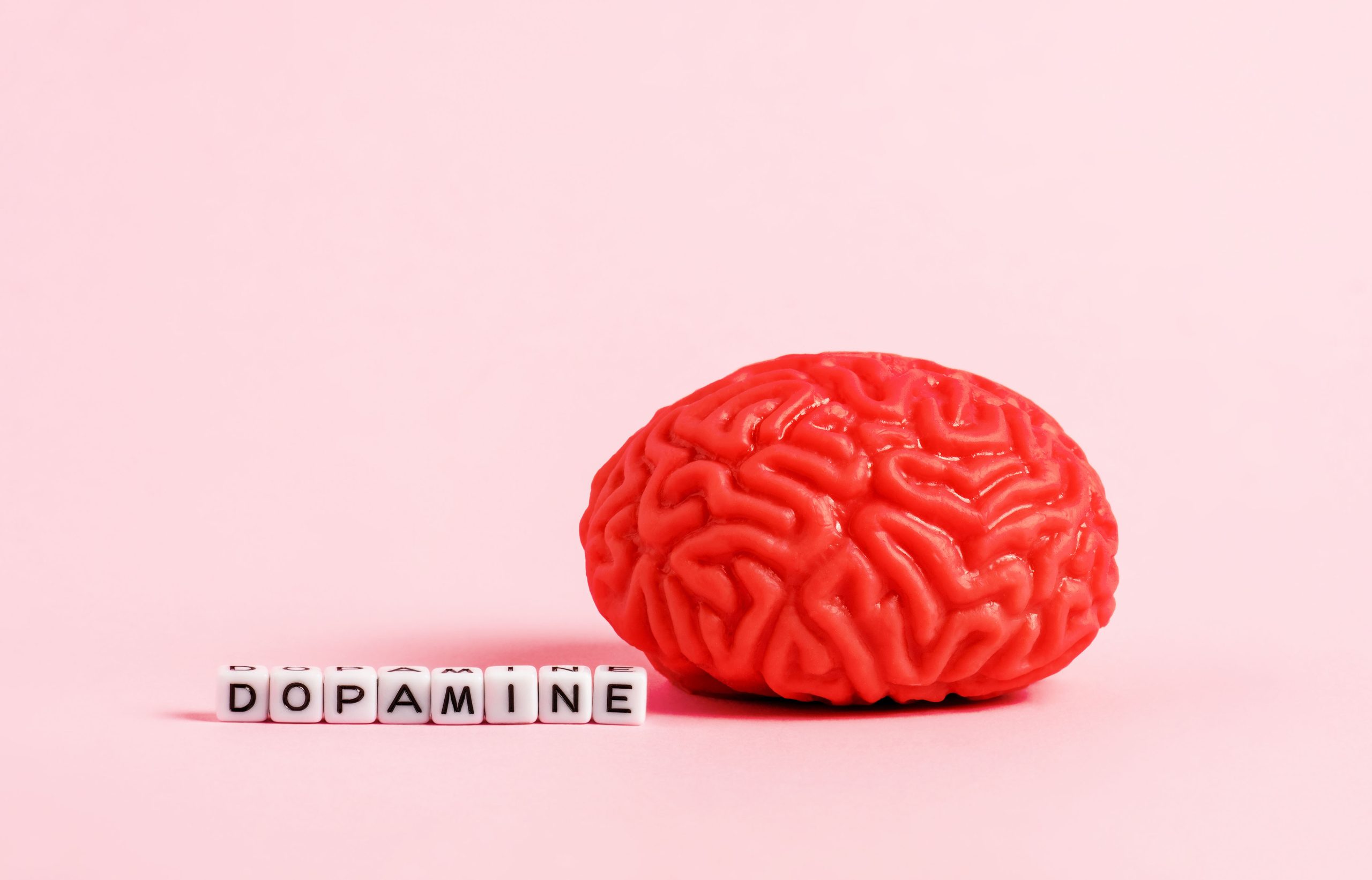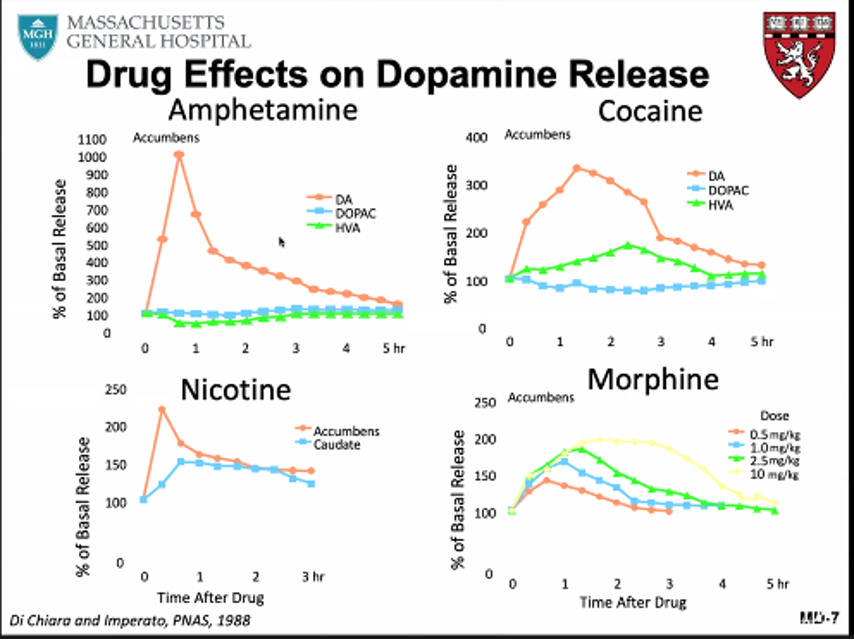The first thing we have to understand is that the addictive substance or behavior in question and its use begins to be experienced as a basic need such as drinking water, eating or sleeping for the person suffering from the addiction.
As it is perceived as a basic need, people with addictive problems turn to the substance or behavior again and again despite the fact that it causes negative consequences in their lives. This is due to the fact that stopping consumption is experienced like stopping breathing for them at a neurobiological level.
Dopaminergic hypothesis of addictions
The scientific community agrees that the dopaminergic hypothesis of addictions is the explanation with the most evidence regarding why people develop addictive disorders. An addictive disorder implies a dysregulation of the brain’s reward circuit.
The reward circuit
The reward circuit, also known as the pleasure circuit, is responsible for facilitating our survival. This system is where dopamine processing occurs in the brain. Dopamine is the pleasure hormone and thanks to it and the reward circuit we can experience, feel and interpret pleasure. The reward circuit is a series of connections between different areas of the brain, mainly the prefrontal cortex and the reptilian brain.

The reptilian brain is a set of areas such as the ventral tegmental area or the nucleus accumbens, and it is responsible for emotional memory and the survival instinct. It is a more primitive area of the brain and has not changed much throughout human history, especially when compared to the prefrontal cortex. Our reptilian brain today is very similar to that of other animals.
The prefrontal cortex is the most modern area of the brain, as it has evolved the most in human history. If we compare a brain of homo sapiens and that of a modern human, the greatest differences would be found in the larger size and connectivity of the prefrontal cortex. The prefrontal cortex is in charge of higher level thinking, decision-making, processes related to motivation and achievement of goals, discerning between good and evil, etc. In short, it is of great importance in terms of the direction and execution of behaviors.
To fully understand addictions in the brain, we must know that the reward circuit aims to guarantee our survival and uses the secretion of dopamine to reinforce behaviors so that they are repeated. All behaviors that are linked to our survival secrete dopamine, for example, drinking water, eating, raising children, etc. This helps them to be experienced as something pleasant and repeated in the future.
There are a series of behaviors that arise in a more recent part of human history such as drinking alcohol, getting drunk, consuming drugs by different means of consumption (oral, smoked, snorted, injected) or gambling. At the dopaminergic level, these behaviors present a great challenge to our reward system, since in nature we do not find anything that is as reinforcing at the level of dopamine as these behaviors.
There is an exponential difference in dopamine levels between the behaviors that are typically abused (drugs, gambling) compared to other behaviors in our daily lives.

We can see how cocaine consumption leads to dopamine levels in the nucleus accumbens of more than 250% above the base level, while other pleasurable behaviors such as sex or eating would increase it between 100% and 50% above the base level respectively. Although different substances generate different spikes in dopamine, drugs or gambling are characterized by generating levels of dopamine that are not found in the person’s natural environment and, therefore, are more capable of generating addiction than other behaviors or substances in nature. However, any behavior that generates dopamine would have the potential to become addictive, which is why you can find cases of addictive problems with food, sports, social networks, sex, video games or the internet, among many others. The person’s relationship with such behaviors becomes toxic and begins to have different consequences in the person’s life.
Upregulation of dopaminergic neurotransmitters
When the abuse of a certain substance or behavior becomes habitual enough, the dopaminergic neurons of the reward circuit will undergo an upregulation of their dopaminergic transmitters due to the high amount of dopamine they are now regularly working with. It can be said that when the dopaminergic neurons of the reward circuit upregulate their neurotransmitters, a person has the disease of addiction. This upregulation will be a determinant in an addictive problem being maintained over time and in the inability to stop consuming as it is the main cause of craving. Craving describes a brief and intense period of time in which a person feels an urge to consume, accompanied by thoughts about consumption, as well as other psychological and physiological reactions.
Abstinence: When you stop using...
When a person stops using, the upregulation of neurotransmitters is reversed, which leads to the spacing out of the craving episodes over time while they reduce their intensity. This process could last from a few months to years after quitting consumption and, in any case, a relapse could reactivate the entire reward system back to the levels that existed during active addiction. This is possible thanks to brain neuroplasticity: the ability of our brain to change the way it connects areas to each other.
Awareness of the disease for those who suffer from addiction problems is essential to stay in recovery. Consumption or execution of the addictive behavior will cause the reward system to stimulate the connections previously established during active addiction and in turn reactivate all of the person’s old attitudes and defensive mechanisms associated with their addiction. It will be essential for the person to take advantage of this stage to generate new strategies for managing their emotions, work on their beliefs about life, about themselves and the world, as well as hobbies that help them fill the time and emptiness caused by abandoning addictive behavior.

The Reptilian Brain Hijacking the Prefrontal Cortex
The prefrontal cortex tries to regulate addictive behavior through attempts to control or stop consumption, but when the reptilian brain, specifically the nucleus accumbens, requires large amounts of dopamine, it will hijack the prefrontal cortex and, consequently, the ability to make rational decisions. When the reptilian brain craves dopamine, it dictates a person’s behavior. It is important that we understand that addictions cause dysregulation of the brain which leads to emotion dysregulation. Planning and executing the behavior leads to dopamine segregation, the person also perceives that these actions lead to pleasant sensations and a better mood, which reinforces the behavior.
Of course, this does not make the person less capable or intelligent, simply someone who, in addition to the basic needs that we all know, perceives that they have another need due to the disease. In order to maintain consumption, it is essential that the disease produces protection mechanisms against other people or against the prefrontal cortex itself (which tries to regulate consumption). Mechanisms such as denial, minimization, lying, concealment and many others. Denial can provoke angry responses towards people who try to control the addict’s consumption. There are also many internal mechanisms to protect the addiction from the prefrontal cortex, such as control perception or downplaying the negative consequences.
Addicted people intend to stop consuming from their prefrontal cortex, but when the reptilian brain craves dopamine, it takes control of the behavior and activates mechanisms to continue consumption. Addiction is not chosen, therefore, no one should be blamed for it but assume responsibility and start taking actions to change. If you think you or someone else has these kinds of problems, seek help.
About the author
Héctor Pastor Pardo is a general health psychologist, specialist in addictions and individual and couples therapy. Trained in third-generation therapies and in psychopharmacology and drugs of abuse, he applies a cognitive-behavioral and integrative approach. Its main activity is in the treatment of adults and couples.
Division of Psychology, Psychotherapy and Coaching
Psychologist
Adults and couples
Languages: English and Spanish

